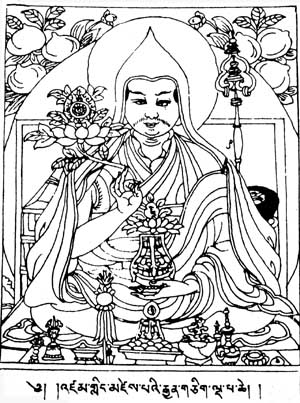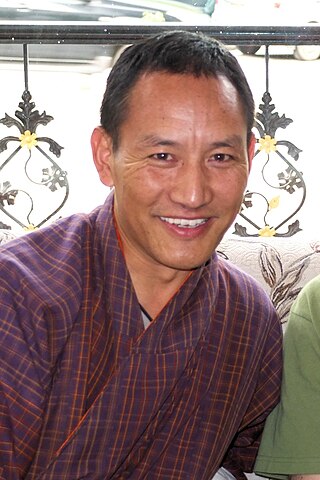
Bhutan's early history is steeped in mythology and remains obscure. Some of the structures provide evidence that the region has been settled as early as 2000 BC. According to a legend it was ruled by a Cooch-Behar king, Sangaldip, around the 7th century BC, but not much is known prior to the introduction of Tibetan Buddhism in the 9th century, when turmoil in Tibet forced many monks to flee to Bhutan. In the 12th century, the Drukpa Kagyupa school was established and remains the dominant form of Buddhism in Bhutan today. The country's political history is intimately tied to its religious history and relations among the various monastic schools and monasteries.

Jigme Dorji Wangchuck was the 3rd Druk Gyalpo of Bhutan.

Ngawang Namgyal and known colloquially as The Bearded Lama, was a Tibetan Buddhist lama and the unifier of Bhutan as a nation-state. In addition to unifying the various warring fiefdoms for the first time in the 1630s, he also sought to create a distinct Bhutanese cultural identity separate from the Tibetan culture from which it was derived.
Articles related to Bhutan include:

Zhabdrung was a title used when referring to or addressing great lamas in Tibet, particularly those who held a hereditary lineage. In Bhutan the title almost always refers to Ngawang Namgyal (1594–1651), the founder of the Bhutanese state, or one of his successive reincarnations.

Gongsar Ugyen Wangchuck was the first Druk Gyalpo (King) of Bhutan from 1907 to 1926. In his lifetime, he made efforts to unite the fledgling country and gain the trust of the people.

Chagri Dorjeden Monastery, also called Cheri Monastery, is a Buddhist monastery in Bhutan established in 1620 by Ngawang Namgyal, 1st Zhabdrung Rinpoche, the founder of the Bhutanese state.

The Second Tibetan Invasion of Bhutan or the Second Battle of Simtokha Dzong was a military confrontation in 1634 between the supporters of Zhabdrung Ngawang Namgyal and the forces of the Tibetan Tsangpa dynasty and several Bhutanese lamas allied against him. The latter initially conquered Zhabdrung's seat, Simtokha Dzong, threatening to eliminate his young dominion. The castle's ammunition stores were accidentally ignited during the battle, however, resulting in an explosion that destroyed Simtokha Dzong and much of the Tibetan army. Seizing this chance, Zhabdrung's followers rallied and ousted the Tibetans from their territory, turning the battle into a decisive strategic victory of Ngawang Namgyal, paving the way for the Unification of Bhutan under his rule.
The Druk Desi was the title of the secular (administrative) rulers of Bhutan under the dual system of government between the seventeenth and nineteenth centuries. Under this system, government authority was divided among secular and religious administrations, both unified under the nominal authority of the Zhabdrung Rinpoche. Druk, meaning "thunder dragon", refers symbolically to Bhutan, whose most ancient name is Druk-yul. Desi, meaning "regent", was the chief secular office in realms under this system of government.

Tenzin Rabgye (1638–1696) was the fourth Druk Desi who ruled from 1680 to 1694. He is believed to have been the first to have categorized formally the zorig chusum. In 1688, he renovated Tango Monastery, approximately 14 kilometres from Thimphu. In 1692, he was first formally categorized during the rule of Tenzin Rabgye (1680–1694), the 4th Druk Desi. In 1692, he visited the sacred cave of Taktsang Pelphug during the Tsechu season and founded a temple there devoted to Padmasambhava. The temple is known as Taktsang Lhakhang and was completed in 1694.

Paro Taktsang, is a sacred Vajrayana Himalayan Buddhist site located in the cliffside of the upper Paro valley in Bhutan. It is one of thirteen Tiger's Nest caves in historical Tibet in which Padmasambhava practiced and taught Vajrayana.

Tenzin is a Tibetan given name, meaning "the holder of Buddha Dharma". Tenzin can alternatively be spelled as Tenzing and Stanzin as well. Stanzin is generally used by the Ladakhi people, since Ladakhi language retains many archaic forms which have been lost in other modern Tibetan languages. For example, in Standard Written Tibetan, 'Tenzin' is spelled as "bstan'zin"; however, when it is spoken, both the 'b' and the 's' are silent and 'an' becomes 'en' in Standard Lhasa Tibetan. It may refer to any of the following people:

The Dual System of Government is the traditional diarchal political system of Tibetan peoples whereby the Desi coexists with the spiritual authority of the realm, usually unified under a third single ruler. The actual distribution of power between institutions varied over time and location. The Tibetan term Cho-sid-nyi literally means "both Dharma and temporal," but may also be translated as "dual system of religion and politics."

Desi Jigme Namgyal of Bhutan is a forefather of the Wangchuck Dynasty. He served as 48th Druk Desi of Bhutan (1870–1873), and held the hereditary post of 10th Penlop of Trongsa. He was called the Black Ruler.

The Khoshut Khanate was a Mongol Oirat khanate based on the Tibetan Plateau from 1642 to 1717. Based in modern Qinghai, it was founded by Güshi Khan in 1642 after defeating the opponents of the Gelug school of Tibetan Buddhism in Tibet. The role of the khanate in the affairs of Tibet has been subject to various interpretations. Some sources claim that the Khoshut did not interfere in Tibetan affairs and had a priest and patron relationship between the khan and Dalai Lama while others claim that Güshi appointed a minister, Sonam Rapten, as de facto administrator of civil affairs while the Dalai Lama was only responsible for religious matters. In the last years of the khanate, Lha-bzang Khan murdered the Tibetan regent and deposed the 6th Dalai Lama in favor of a pretender Dalai Lama.
Pagsam Wangpo, a key figure in the history of the Drukpa Lineage of Tibetan Buddhism, was born at Chonggye, in the Tsang province of Tibet a natural son of the prince of Chonggye, Ngawang Sonam Dragpa. He was an elder cousin of the 5th Dalai Lama, Ngawang Lobzang Gyatso (1617-1682).

Lopen Karma Phuntsho is a former monk and Bhutanese scholar who specialises in Buddhism, Tibetan & Himalayan Studies and Bhutan, and has published a number of works including eight books, translations, book reviews and articles on Buddhism, Bhutan and Tibetan Studies. His The History of Bhutan has been called "the first book to offer a comprehensive history of Bhutan in English" and received Choice Outstanding Academic Title Award in 2015.
Gaeboo Achyok or Gyalpo Ajok was a Lepcha chieftain of a principality based at Damsang, presently in the Kalimpong district of West Bengal, India.
Shingkhar Lam Kunzang Wangchuk was a Bhutanese politician, who served as a speaker of the Gyelyong Tshogdu. After his uncle went missing, he served two Druk Gyalpos (kings) of Bhutan. He created the insignia for the Royal Bhutan Army and rewrote the Druk Tsendhen.














